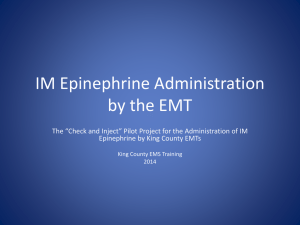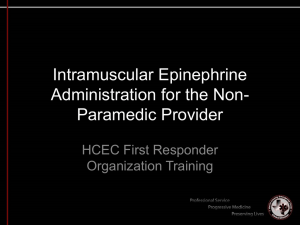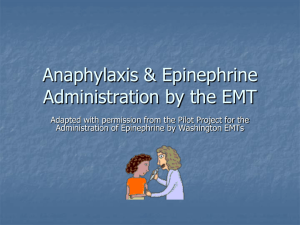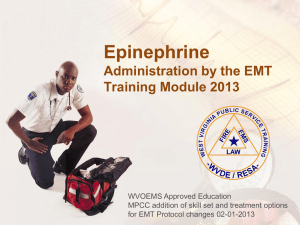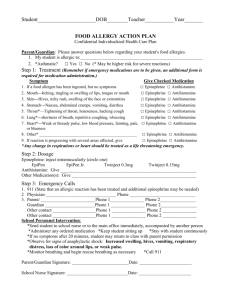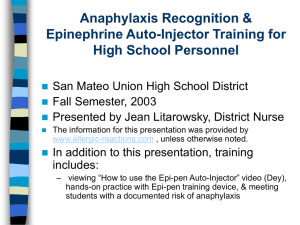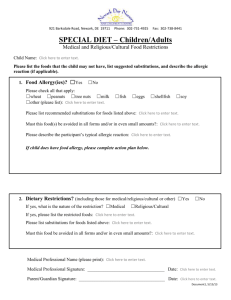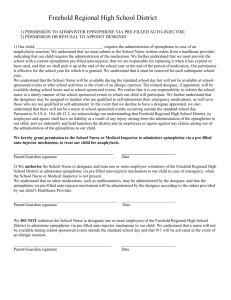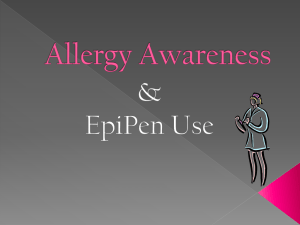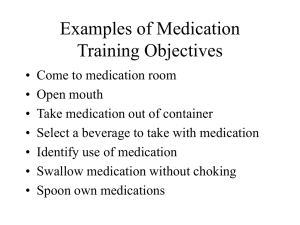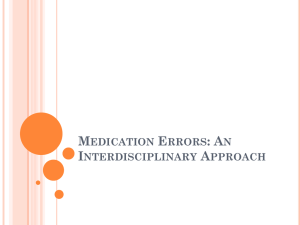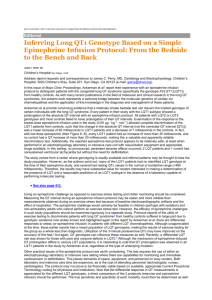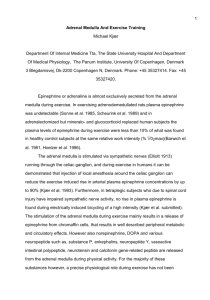Epinephrine Administration by the EMT
advertisement
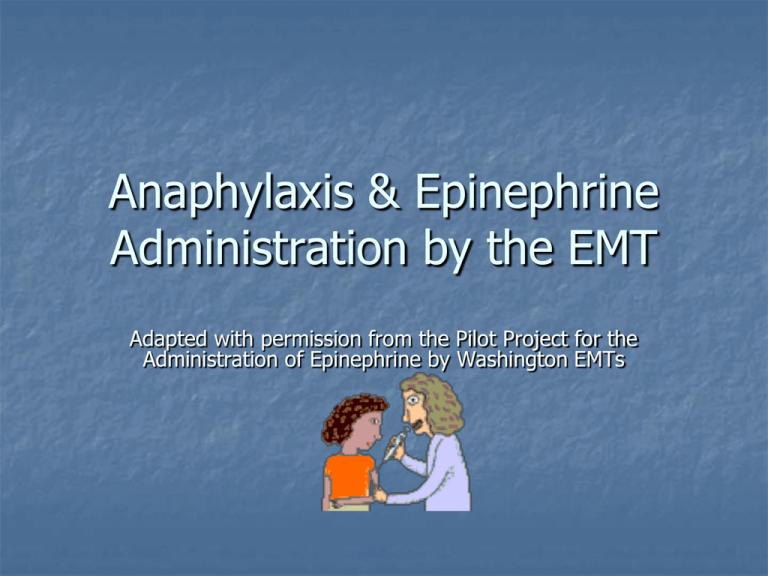
Anaphylaxis & Epinephrine Administration by the EMT Adapted with permission from the Pilot Project for the Administration of Epinephrine by Washington EMTs Learning Objectives: With successful completion of this training module, the EMT will be able to describe and/or correctly demonstrate … Epinephrine identification as a medication, steps in aseptic technique, preparation of Epinephrine for administration, intramuscular administration of Epinephrine, & the mechanism of action and effects of Epinephrine During this presentation, check your answer to study questions by clicking on this icon: Key Terms Anaphylaxis - a life-threatening, hypersensitivity reaction of the immune system Aseptic technique - a procedure performed under sterile conditions Asphyxia - suffocation as a result of blockage of the airway Dyspnea - labored or difficult breathing Epinephrine - a hormone released from the adrenal glands that activates several tissues in the “fight-or-flight” response Histamine - one of several chemical messages released from immune cells that promote inflammation as a defense mechanism Intramuscular - a medication route by injection into the belly of a muscle which encourages rapid transport by the bloodstream Shock - a severe reduction in blood pressure (by any cause) that results in inadequate blood flow (oxygen & glucose) to tissues What is Epinephrine? A synthetic reproduction of the naturally occurring hormone Epinephrine Released during “fight or flight” responses reflex stimulation of the adrenal gland sympathetic division of the autonomic nervous system During “fight or flight” reactions, the airways _____________ . (dilate or constrict) Examples of the Medication • Name of medication • Concentration (1:1,000 or 1mg/1ml) • Expiration date Indications for Use EMTs may administer Epinephrine for: Anaphylaxis Anaphylactic shock Is this a different dose than when using the Epi-pen? Dosage: Adults - 0.30 mg of 1:1,000 Pediatrics - 0.15 mg of 1:1,000 > 30kg (66 lbs) < 30kg (66 lbs) Anaphylaxis is an over-reaction of the Immune System Sudden, severe allergic reaction involving the whole body Most common allergens: insect sting, food, medication, latex Widespread immune system response causes itching, hives & swelling May also cause circulatory shock; tracheal and bronchial swelling resulting in asphyxia What respiratory signs would be typical of anaphylaxis? Action of Epinephrine Relaxes smooth muscle in the airways Counteracts histamine and other cytokines Raises blood sugar level Raises heart rate, blood pressure, and myocardial oxygen demand For Intramuscular injection of Epinephrine… Onset of effect: 3-5 min Duration of effect: 1-4 hours Some Side Effects of Epinephrine will occur: Palpitations Tachycardia & arrhythmias Hypertension Which vital signs are important to document Headache before and after Tremor, weakness administering Pallor, sweating epinephrine? Nausea & vomiting Nervousness & anxiety Pain, redness at the injection site Six Rights of Drug Administration 1. 2. 3. 4. 5. 6. Right person Right drug Right dose Right time Right route Right documentation Site Selection and Preparation Intramuscular sites allow a drug to be injected into the belly of a muscle so that the blood vessels supplying that muscle distribute the medication to its site of action via the bloodstream. First steps: 1. 2. What PPE should be worn when preparing the medication and injection site? Prep the site with approved antiseptic by scrubbing vigorously and allowing to dry. DO NOT TOUCH, BLOW ON OR FAN THE INJECTION SITE! Align the syringe and needle above the injection site at a 90 degree angle, with the bevel of the needle facing up. Intramuscular Injection 90º How much longer will it take to treat anaphylaxis if epinephrine is administered too shallow (in the subcutaneous layer), rather than in the muscle? Intramuscular Injection Sites Deltoid Rectus femoris Vastus lateralis Where is the best IM injection site for an infant? Needle Handling Precautions Minimize the tasks performed in a moving ambulance. Immediately dispose of used sharps in a sharps container. Recap needles only as a last resort. Ampules and Vials Store epinephrine AWAY from light; leave it in its carton until ready to use. Also keep away from extreme heat and danger of freezing. Vials Ampules Document all information concerning the patient and medication, including: Indication for drug administration 1. include appearance, work of breathing, vitals, lung sounds, skin signs, and ability to speak Drug, dosage, and delivery site Patient response to the medication 2. 3. include appearance, work of breathing, vitals, lung sounds, skin signs, and changes in ability to speak both positive and negative responses Obtaining Medication from a Glass Ampule Confirm the Medication Medication name Dosage (1:1,000 or 1mg/1ml) Expiration date Not cloudy; no color or precipitate Hold the ampule upright and tap its top to dislodge any trapped solution. Place gauze around the thin neck… …and snap it off with your thumb. Draw up the medication. Using a 1cc syringe, insert the needle into the ampule and draw the plunger back on the syringe until you reach the correct dosage (0.15 cc or 0.30cc) for the weight of the patient. Obtaining Medication from a Vial Confirm the Medication Medication name Dosage (1:1,000 or 1mg/1ml) Expiration date Not cloudy; no color or precipitate Prepare the syringe and hypodermic needle. Clean the vial’s rubber top. Insert the hypodermic needle into the rubber top and inject the air from the syringe into the vial. Withdraw the appropriate volume of medication. © Scott Metcalfe Using a 1cc syringe, insert the needle into the vial or ampule, draw the plunger back on the syringe until you reach 0.3cc mark on the syringe. Prepare the site. © Scott Metcalfe Scrub the skin vigorously with an alcohol wipe Allow to air dry (do not blow on or fan it) Insert the needle at a 90-degree angle. © Scott Metcalfe Stretch the skin taut Do not pinch it Hold the syringe like a dart Insert the needle with a quick stab at a 90° angle to the skin surface Remove the needle and cover the puncture site. © Scott Metcalfe Assessment of Patient Response Document patient’s response to treatment: LOC, behavior, breathing effort, lung sounds, skin signs, vital signs, and changes in ability to speak Document adverse effects, if any How long does it take for the drug to take effect, and what do I do if the patient does not improve? Any questions? The body’s stress response causes the normal release of epinephrine to maintain homeostasis during vigorous activity: “fight or flight”. These same actions of epinephrine counteract e.g. the bronchoconstriction and low blood pressure of anaphylaxis when administered by medical personnel. Airway dilation Breathing rate increases Blood flow to skeletal muscles increases EPINEPHRINE Blood pressure increases back Heart rate increases Pupils dilate Blood sugar level increases Epi-Pen dosages Pediatrics Adults - 0.15 mg of 1:1,000 - 0.30 mg of 1:1,000 The same dosage schedule is used in anaphylaxis, no matter the method of IM administration. back Respiratory Signs & Symptoms Shortness of breath Hoarseness, wheezing, or other abnormal sounds of breathing Hives, itching, swelling and/or spasm Rapid and/or labored breathing, use of accessory muscles, prolonged expirations, hypoventilation, decreased lung sounds back Document Vital Signs before and after treatment with Epinephrine Because epinephrine is expected to cause widespread changes in function, it is important to frequently monitor and document vital signs: HR, RR, BP include general appearance, work of breathing, lung sounds, skin signs, and ability to speak back Always wear PPE when treating patients Wear gloves and goggles when assessing the patient, preparing the medication, cleaning the site of injection, and administering the drug. back Be sure to inject Epinephrine into the muscle It may take twice as long (up to 10 min) for epinephrine to have it’s life-saving effect if not injected into the muscle. back Vastus lateralis (lateral thigh) is the best site for infants Good site for all ages Far from major blood vessels & nerves back Ongoing Assessment If no significant improvement within 10 minutes, consider second dose Second dose requires consultation with online medical control If unable to contact medical control or ALS unit, EMT may administer second dose if patient condition warrants Thorough documentation is essential back
